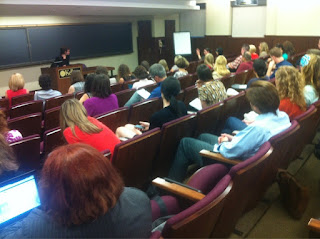Many people building websites have big problems with their content. It’s a nearly universal problem, and it’s enormously complicated. Content is hard. Content piles up. Content is messy. People are still learning about it and figuring out what fixes the content problem.
If you’re just beginning to learn about content strategy, the best place to start is with the woman leading the charge to make web content better, and Kristina Halvorson is that content cheerleader. She is the industry’s top voice for content strategy, and last Tuesday evening Halvorson met with Chicago-area professionals for a fun and informal conversation about content strategy at Northwestern University’s Kellogg School of Management.
She shared ideas on how key business messages inform content strategy and how they impact development and design. Here are some simplified takeaways from her talk:
People are not coming to your website for your code. They’re coming for your content. People visit an organization or company’s website to help them solve a problem or fill a need. Content is the building block of everything we do, ever. It can’t just be a by-product of the web development process.
Content is alive, and content is affected by so many sources.
Instead of flowing lorem ipsum into designs, use real copy.
Wave the content flag as soon as the project starts. Don’t wait to think about content. Content deserves to be considered strategically. When developing content, ask: Who is your audience? What are you trying to do with the website? What gets the click? What helps make the sale? Take the time to identify which metrics matter when you’re trying to figure out what content works.
Organizational design, as well as roles and responsibilities, has a lot to do with the slow growth of content strategy as a priority in web development, but things are getting better. More people are able to talk about content-related problems. In your organization or company, establish who owns what and figure out that and put an audit system in place. This will help to establish ownership and accountability for content. Continually audit and monitor initiatives to figure out the impact of changes to the content ecosystem.
There is a difference between copywriting and getting content into a life cycle. “It’s only one page.” “Just get it up.” “I know it’s not hard to put up one page.” Have a strategy for dealing with this kind of request about adding content. Understand your content ecosystem and figure out what its limitations mean for your ability to organize and create content. If you’re facing restrictions, consider the strategy of putting as little content out there as possible.
Content management systems do not solve content problems. Even if you have a CMS you still need a content strategy with a plan for workflow and governance.
Need help developing a content strategy for your website? TBH Creative specializes in website strategy and web redesign for organizations and businesses. We’ll help you figure out where to go next and explore your options.

